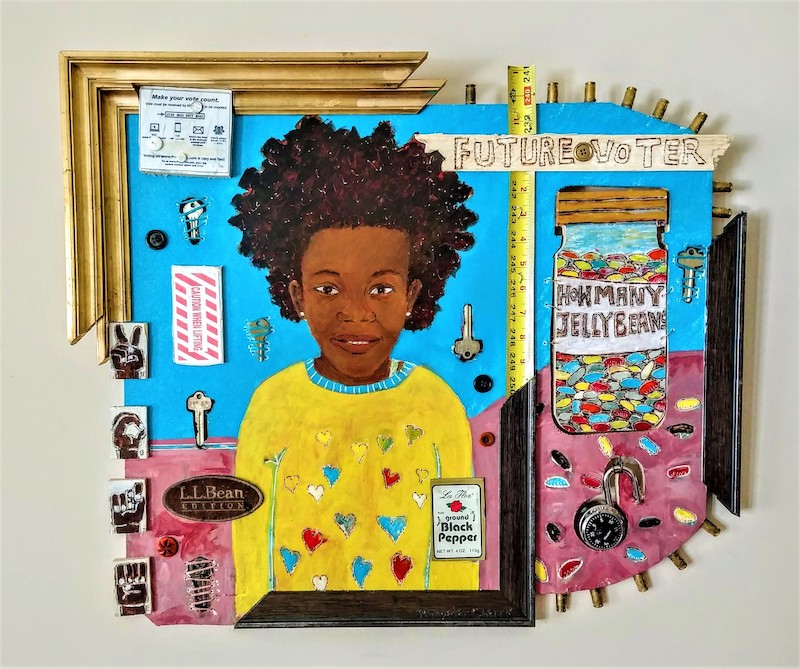Future Voters #4 Jelly Beans, 2021, 23” x 27”, assemblage painting (acrylic with objects on wood)
Some people cannot stay still.
“My parents always said I burned a candle on both ends,” says Schroeder Cherry, noting this holds especially true with his art career. “I have three tracks: museum work, art making, and puppetry.”
Working daytime hours as the curator at the James E. Lewis Museum of Art at Morgan State University, Schroeder is in his studio at the start and end of each day.
“I’m an early morning and late night person,” he says. “My mantra is ‘produce, perform, exhibit, travel, sell.’ I try to do one of those things every day. I need to do something every day that feeds the work.”
As with many artists, Schroeder’s drive to be an artist comes more out of need than want.
“Not being able to make art would deprive me of something very basic,” he says.
Most recently, Schroeder has been producing a series on the topic of future voters.
“I came up with the idea when I got tired of the news media with so many stories of voter suppression. There are a lot of young people experiencing this, and one day they’ll be voters – what they absorb will have an impact on what happens to them.”
Schroeder fears that young Black people will accept as a given they are disenfranchised as voters. He wants to challenge that narrative with alternative ones – such as he seeks to do with Future Voters #4 Jelly Beans.
Dominating the image is a portrait of a young girl with a jar of jelly beans to her left, a reference to the Jim Crow era (Black voters sometimes were made to guess the number of jelly beans in a jar before being allowed to vote). While a unifying pink and blue background implies the girl and jar inhabit the same space, an edge of picture frame and an extended tape measure bisect the image, creating a visual boundary between the jar and the girl – as if the two exist in separate worlds. Formally, the two subjects echo one another: each is cylindrically shaped (the girl’s symmetrical sweater-cloaked body, the stolid glass jar); each with a topping of brown (the face of the girl, the cap of the jar); each patterned with bits of color (the hearts on the sweater; the jelly beans).
A kind of dialectic is established: the jar and its bitter history contrasted with the girl in all her brightness – a dark past ameliorated by the hint of a better future.
Embellished with a multitude of suggestive details (an unclasped lock, empty bullet casings patterned along the edge, keys bound and unbound in twine), the work is replete with possible interpretations.
“Much of my composition is intuitive,” says Schroeder. “My art is more visual than direct narrative. What I appreciate are the potential stories that come up after the fact.”
Happy to leave reading the specific meaning of his work up to others, Schroeder has found making art in response to his consternation over voter suppression to be cathartic.
“It helps me release some pent-up emotions. I could not live without what I get from making things. I mean, why do I breathe? It’s who I am, it’s what I do.”
Which brings us back to Schroeder’s work ethic – an ethic born of necessity before a world of injustice and pain. For Schroeder, art-making is a constant practice of resilience – of taking negative experiences and growing and moving on from them.
“I believe in the dual side of things,” he says. “What might seem like a catastrophe at one point is often an opening to something more positive. My art helps remind me of that. It helps me keep focused on the entire journey, not just the part that is painful.”
Taking on hard things with a perpetually optimistic attitude, Schroeder’s daily practice of making art becomes his recurring salvation.
“Don’t deny the pain, but don’t let that stop you.”
And he doesn’t.
Schroeder Cherry is an artist, puppeteer, and museum professional who lives in Baltimore, MD. He will appear as a guest at Bruun Studios’ Becoming event taking place February 17. For details and to register, go here.

